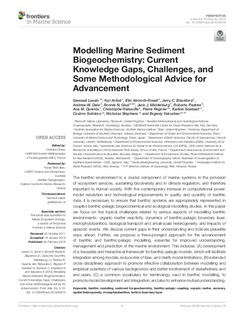| dc.contributor.author | Lessin, Gennadi | |
| dc.contributor.author | Artioli, Yuri | |
| dc.contributor.author | Almroth-Rosell, Elin | |
| dc.contributor.author | Blackford, Jerry C | |
| dc.contributor.author | Dale, Andrew W | |
| dc.contributor.author | Glud, Ronnie N | |
| dc.contributor.author | Middelburg, Jack J | |
| dc.contributor.author | Pastres, Roberto | |
| dc.contributor.author | Queirós, Ana M. | |
| dc.contributor.author | Rabouille, Christophe | |
| dc.contributor.author | Regnier, Pierre | |
| dc.contributor.author | Soetaert, Karline | |
| dc.contributor.author | Solidoro, Cosimo | |
| dc.contributor.author | Stephens, Nicholas | |
| dc.contributor.author | Yakushev, Evgeniy | |
| dc.date.accessioned | 2019-05-14T08:39:12Z | |
| dc.date.available | 2019-05-14T08:39:12Z | |
| dc.date.created | 2019-02-10T18:24:59Z | |
| dc.date.issued | 2018 | |
| dc.identifier.citation | Frontiers in Marine Science. 2018, 5 . | nb_NO |
| dc.identifier.issn | 2296-7745 | |
| dc.identifier.uri | http://hdl.handle.net/11250/2597512 | |
| dc.description.abstract | The benthic environment is a crucial component of marine systems in the provision of ecosystem services, sustaining biodiversity and in climate regulation, and therefore important to human society. With the contemporary increase in computational power, model resolution and technological improvements in quality and quantity of benthic data, it is necessary to ensure that benthic systems are appropriately represented in coupled benthic-pelagic biogeochemical and ecological modelling studies. In this paper we focus on five topical challenges related to various aspects of modelling benthic environments: organic matter reactivity, dynamics of benthic-pelagic boundary layer, microphytobenthos, biological transport and small-scale heterogeneity, and impacts of episodic events. We discuss current gaps in their understanding and indicate plausible ways ahead. Further, we propose a three-pronged approach for the advancement of benthic and benthic-pelagic modelling, essential for improved understanding, management and prediction of the marine environment. This includes: (A) development of a traceable and hierarchical framework for benthic-pelagic models, which will facilitate integration among models, reduce risk of bias, and clarify model limitations; (B) extended cross-disciplinary approach to promote effective collaboration between modelling and empirical scientists of various backgrounds and better involvement of stakeholders and end-users; (C) a common vocabulary for terminology used in benthic modelling, to promote model development and integration, and also to enhance mutual understanding. | nb_NO |
| dc.language.iso | eng | nb_NO |
| dc.publisher | Frontiers Media | nb_NO |
| dc.rights | Navngivelse 4.0 Internasjonal | * |
| dc.rights.uri | http://creativecommons.org/licenses/by/4.0/deed.no | * |
| dc.title | Modelling Marine Sediment Biogeochemistry: Current Knowledge Gaps, Challenges, and Some Methodological Advice for Advancement | nb_NO |
| dc.type | Journal article | nb_NO |
| dc.type | Peer reviewed | nb_NO |
| dc.description.version | publishedVersion | nb_NO |
| dc.rights.holder | © 2018 Lessin, Artioli, Almroth-Rosell, Blackford, Dale, Glud, Middelburg, Pastres, Queirós, Rabouille, Regnier, Soetaert, Solidoro, Stephens and Yakushev | nb_NO |
| dc.source.pagenumber | 8 | nb_NO |
| dc.source.volume | 5 | nb_NO |
| dc.source.journal | Frontiers in Marine Science | nb_NO |
| dc.identifier.doi | 10.3389/fmars.2018.00019 | |
| dc.identifier.cristin | 1675437 | |
| cristin.unitcode | 7464,20,14,0 | |
| cristin.unitname | Marin biogeokjemi og oseanografi | |
| cristin.ispublished | true | |
| cristin.fulltext | original | |
| cristin.qualitycode | 1 | |

